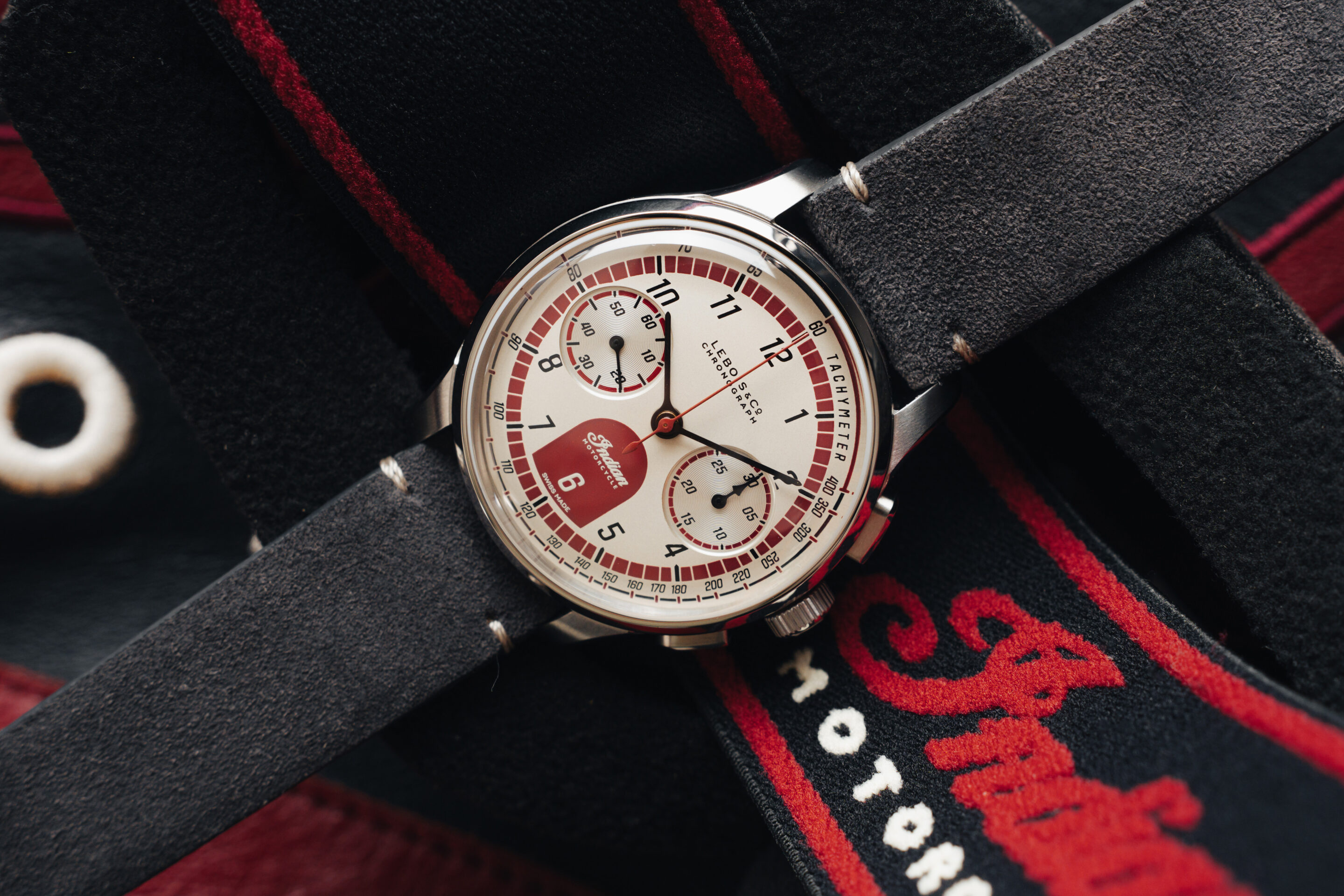CoLAB Heritage Chronograph
Step 2: Cases and Dials
CoLAB Heritage Chronograph
Hello, watch aficionado. We see you, scouring the internet for your regular watch fix. We see your dedication, your love and admiration for these beautifully carved wonders of mechanical accuracy. We see your passion.
Imagine just how wonderful it would be if you could help design your own watch. Maybe you’ve been daydreaming about this for years. Maybe you’ve even been silently sketching your own dials and bezels on your notepad at work. Here’s your chance to change the world of watches. To add real value and make your mark in the long-standing history of Lebois & Co.
Steps in this Project:
Step 1 – April 22, 2021: Choosing inspiration and movement
Step 2 – July 5, 2021: Cases and dials
Step 3 – December 6, 2021: Results in 3D and technical details
Step 4 – October 7, 2022: Prototype evaluation
Chronographs: a Practical Invention
A brief ‘why’ of the chronograph watch
Chronograph watches might be the most well-known type of watches. Since their invention by Louis Moinet more than 200 years ago, chronographs have earned their place as the most versatile addition to the field of timekeeping and time measurement. Initially intended as an aid for astronomical observations; later they were actually used for almost everything from exploring space, landing on the Moon, during warfare and in Formula 1 and even to aid pilots and doctors.
Despite the emergence of digital alternatives, they are still very much in demand by pilots and drivers alike, and the desire for mid-century models has led to a huge boom in the vintage watch market.
Chronographs and their scales: the apps of yore
Chronographs were not just made because they were pretty or interesting to look at. They were useful tools. They were then, what today is an app on your phone. Scales were used to display this app. Like a telemeter scale where you can measure the distance to an object or event. Useful during a thunderstorm but also during war to monitor artillery strikes. Or a tachymeter scale where you can measure the speed over a fixed distance. Very useful on the race track (we are pretty sure Max Verstappen uses one..).
And how about a professional application? Doctors had their own app, the pulsometer, where they could measure a patient’s heart rate. The dial indicates how many heartbeats it is calibrated for. For example, ‘graduè pour 30 pulsations’, which means it can measure how long it takes to count 30 heartbeats. The scale then indicates how many heartbeats this is per minute.
Fun fact; have you ever seen these long markers at 3, 6 and 9 minutes on a chronograph? This was done to help people monior the length phone calls in payphones. In the 1940s and 1950s, if you used a payphone, you got three minutes of talk time. When these three minutes were over, the connection was simply cut off. With the help of the chronograph, people knew exactly when they had to put in extra money or end their phone conversation.
Want to learn more about chronograph dials? Check out ‘Principaux types de chronographes expliqués par leurs cadrans, 1952‘ (translated: ‘Main types of chronographs explained by their dials, 1952’) by FHS.

New Life for a Classic Logo
We reinterpreted Lebois & Co’s original logo
When we breathed new life into Lebois & Co in 2014, this included the creation of a new logo. However, the new logo is sleek and modern and we don’t think it fits a vintage inspired watch like the Heritage Chronograph. Therefore, especially for this watch, we redesigned the old logo. Again, we have stayed as close to the original as possible and in our opinion, the result is worth it! See below.
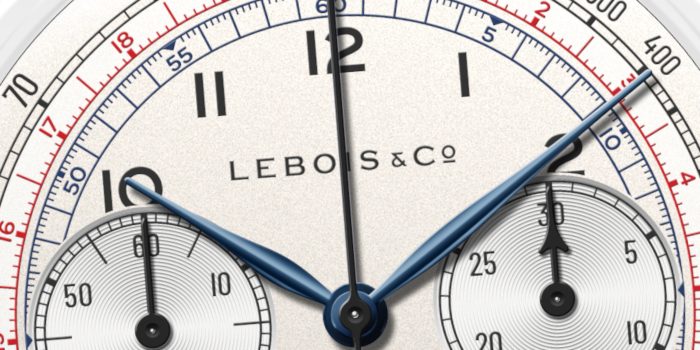
Cast Your Vote: Case Concepts
Choose your favorite case out of three pre-selected concepts
To start our designer Matthieu Allègre has done extensive research into the cases of past Lebois & Co models. From there he has made 6 case concepts from which we have chosen 3 to present to you. From these 3 we invite you to choose the case that you think will fit our Heritage Chronograph the best. For each option, we are going to investigate with our case manufacturer if we can have two bezel options; a sloped and a stepped bezel. A little background on each case concept:
- Concept 1: An unconventional but interesting one. Straight and faceted lugs with thin brushed sides and pushers which are the same shape as the top of the lugs. This concept is inspired by an interesting Lebois & Co vintage piece which had an almost identical twin at a famous brand in the 1940’s.
- Concept 2: Classic explorer brushed lugs with polished bevels to play with the light. This kind of shape might be the most used shape since the 1950’s. The challenge was to draw with pushers that followed the shape of the lugs to add a touch of modernity.
- Concept 3: The perfect mix between modern and vintage. Again a famous vintage shape from the 1950’s and 1960’s. The cut on the bevel give this concept a nice new look without changing the main spirit. This case is also textured with a variation of thin brushed and polished details.
Ready? Let’s do it! Take a look at the 3 case concepts we pre-selected. Use the zoom function to discover the differences. This works by clicking on the appropriate picture. Then, vote for the case concept you like best. Feel free to use the comment section at the bottom of this page to explain your choice.
Vote the case you like best
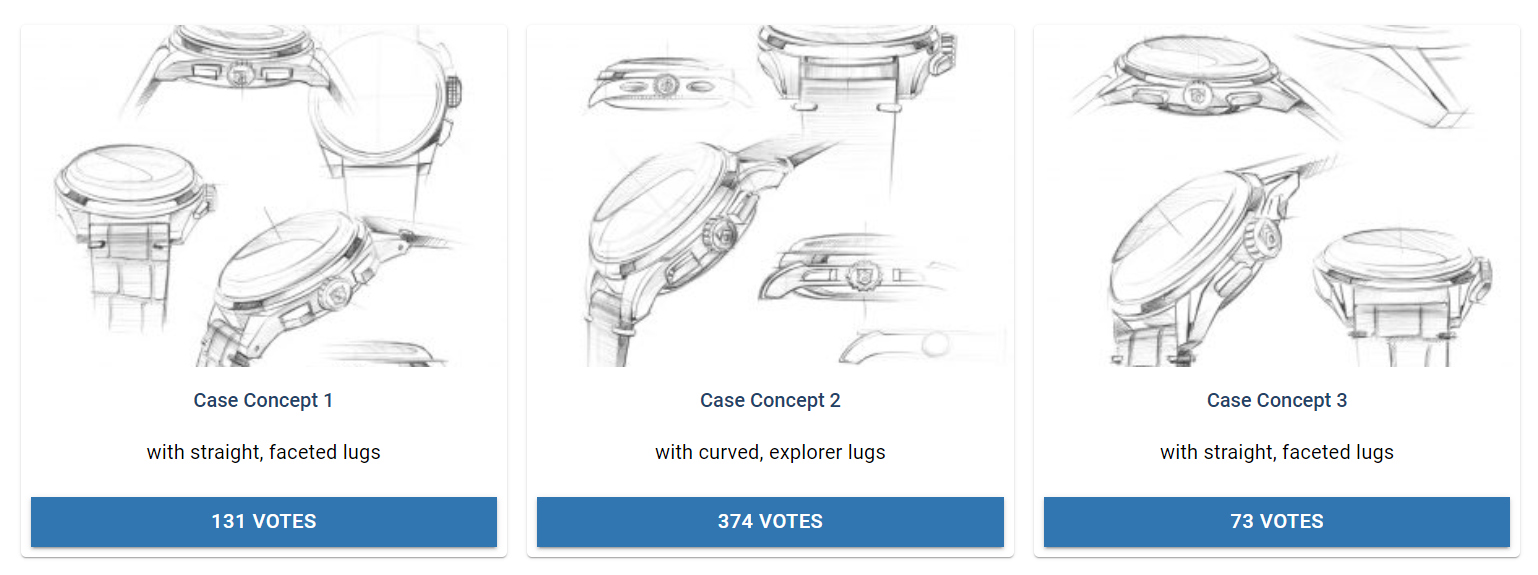
Cast Your Vote: Dials
Choosing a dial for each layout
Over 1,700 votes have been casted on choosing from the different models from the vintage archives in Step 1 of this CoLAB project. The clear winner is the salmon colored dial which was the first watch on the list. Second and third place go to number 5 – cream dial and number 6 with the off-white sector dial. Based on your votes and feedback in Step 1 we decided to design 4 dial layouts (not 3 as stated in the video which we shot a few days before this decision ;-)). First layout is a multiscale (tachymeter, telemeter and minuterie) with applied indexes which will be made in salmon color. Then a cream dial with simliar multiscale but in multiple colors. Third layout is a sector dial in off-white. And fourth… a surprise! A pulsation dial. Although we haven’t found any vintage Lebois & Co chronographs with this kind of layout yet, we still think it belongs in the line-up. The pulsation dial will be made in the color that will be most voted for.
Salmon dial with tachymeter, telemeter scale and minuterie
Choose between a full central sun brushed (1A) and a circular brush mixed with sandblasted at the middle and between the minuterie and telemeter scale (1B). Click the images to zoom in and see the details.
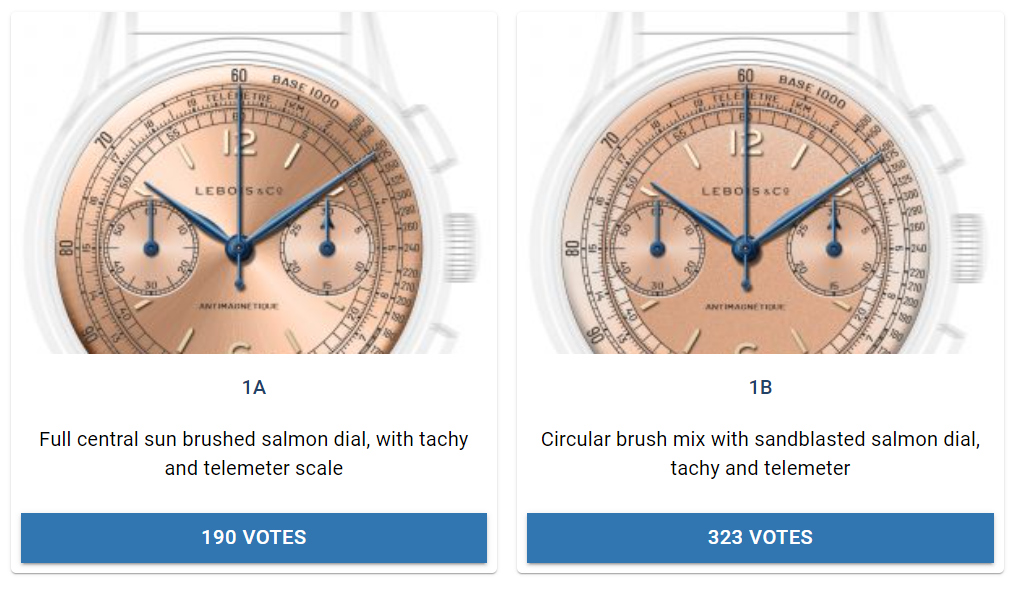
Cream dial with multicolored scales
Choose between a sandblasted cream dial with multicolored scales (tachymeter, telemeter and minuterie) with silver subdials (2A) or subdials in dial color (2B). Click the images to zoom.
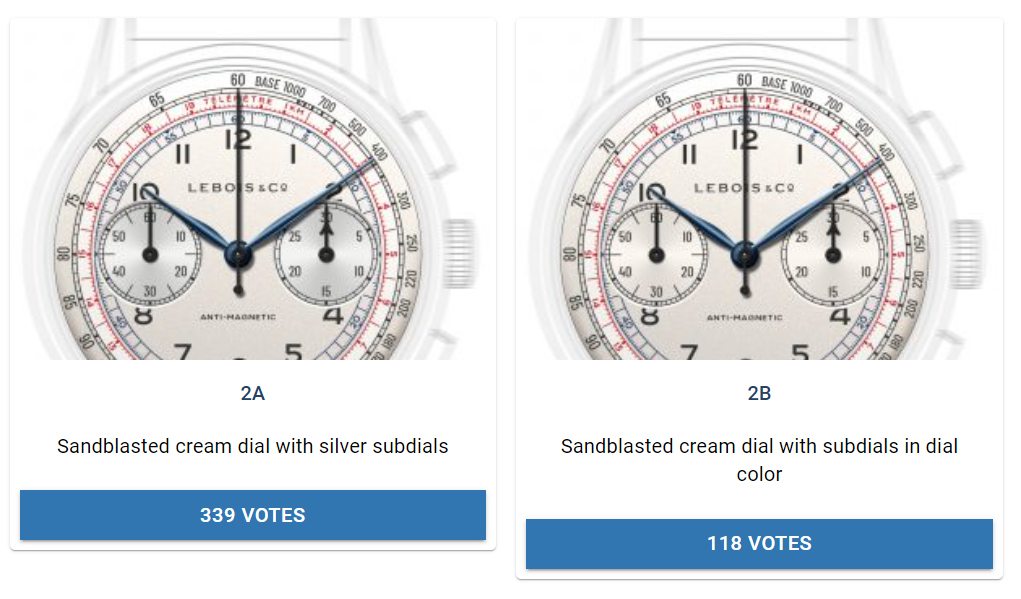
Off-white sector dial with tachymeter
Our interpretation of the popular off-white sector dial with black print and blue tachymeter scale. Choose between a full central sun brushed (3A) or sandblasted dial (3B). To see the difference, zoom in by clicking on the images.
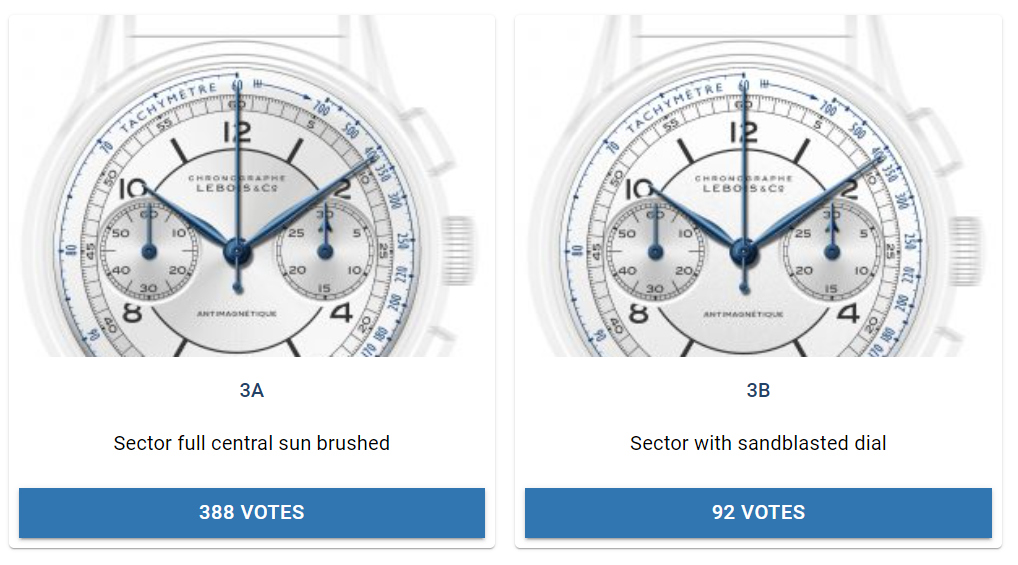
Pulsation dial
Surprise! A genuine pulsation dial. ‘Graduè pour 30 pulsations’, meaning you start the chronograph and stop as soon as you have counted 30 heartbeats with your patient. The chronpgraph’s second hand then points to the amount of heartbeats per minute on the pulsometer scale. The dial has the typical Lebois & Co style azurage pattern behind the indexes.
Choose between a sand blasted off-white dial (4A), a central sun brushed black dial with silver subdials and silver azurage (4B) or a central sun brushed black with gold print (4C).
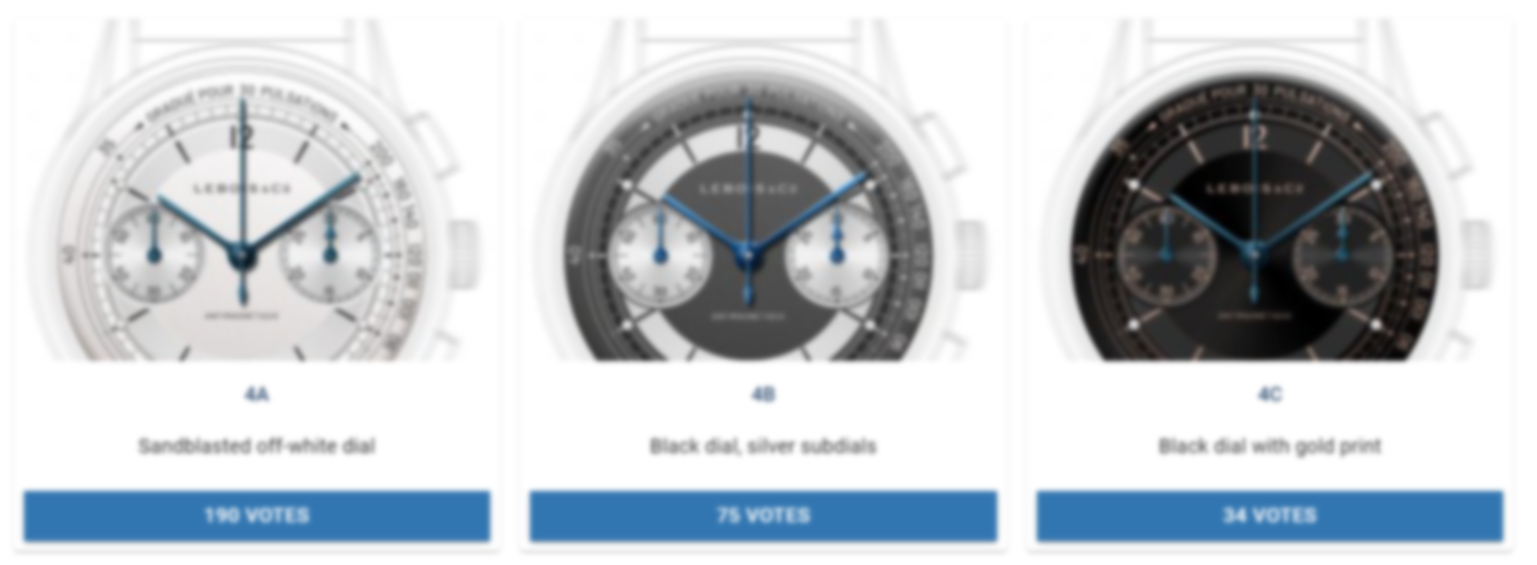
Update: July 18, 2021
Based on your the outcome of the Quick Polls we have added two new dials proposals (4C-v2 and 4D) for the pulsation dial layout.
Choose between a sand blasted off-white dial (4A), a central sun brushed black dial with gold hands and print (4C-v2) or a central sun brushed salmon dial with blue hands (4D).
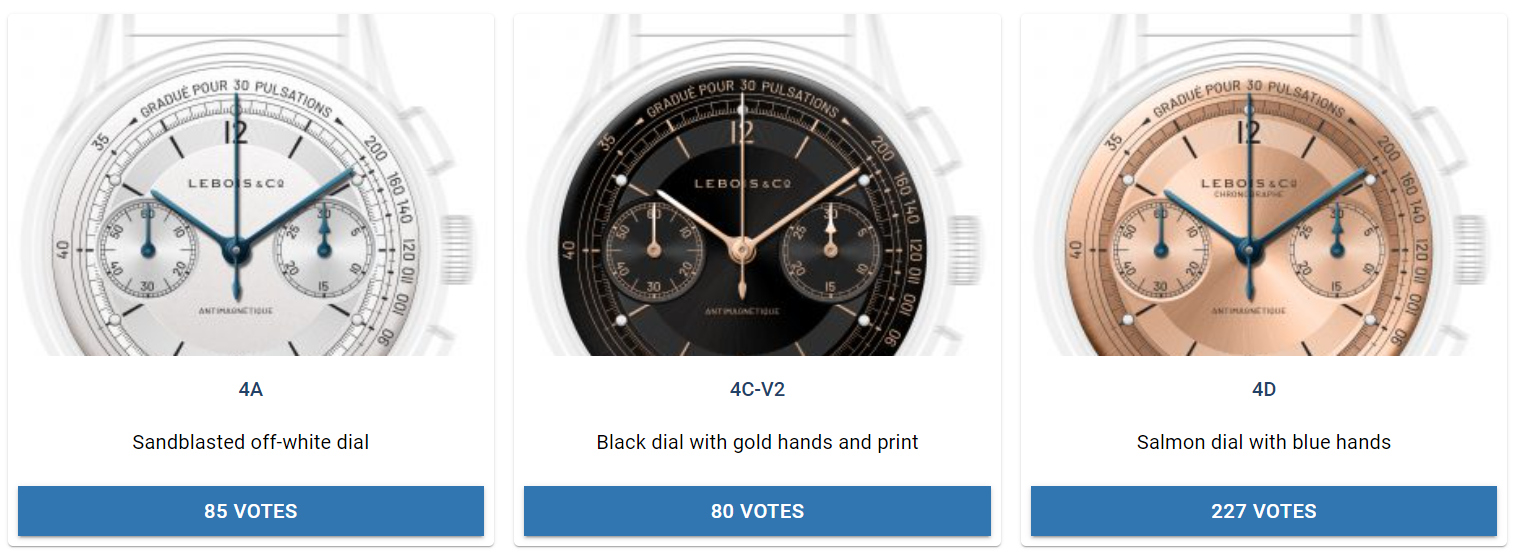
Quick Poll
You talk, we listen
From time to time, we pick up great ideas from the comments and feedback from the community. We present them as a Quick Poll right here to see what the rest of you think.
Closed polls
The polls below have been closed and processed.
Should we propose a salmon colored pulsation dial?
- Yes (87%, 122 Votes)
- No (13%, 18 Votes)
Total Voters: 140
How about gold hands on dial 4C?
- Yes (57%, 71 Votes)
- No (43%, 53 Votes)
Total Voters: 124
Would you prefer the 'TACHYMÈTRE’ text in the tachymeter scale on dial 1 and 2 instead of ‘BASE 1000’?
- Yes (58%, 202 Votes)
- No (42%, 148 Votes)
Total Voters: 350
Project Timeline
Like other attentive fans, you may have noticed that we’ve had to adjust the original timeline several times. We see you. During this particular CoLAB, we’ve encountered multiple setbacks, ranging from production problems to worldwide staff shortages. While these are beyond our influence, we would’ve liked the Heritage Chronographs to be in our and your hands by now.
Thank you for your patience and understanding. We hope (and think!) the quality of the end result will make up for some of the lost time.
| 22 April 2021 | Step 1: Project launch and choosing inspiration + movement |
| 5 July 2021 | Step 2: Cases and dials |
| 6 December 2021 | Step 3: Presenting the results in 3D and technical details |
| 14 December 2021 | Pre-order Round 1 (pre-prototype) |
| 7 October 2022 | Step 4: Prototype evaluation |
| 14 October 2022 | Launch of Pre-order Round 2 |
| October 2022 | Start of final production |
| 16 December 2022 | First movement batch finished |
| 22 February 2023 | Start delivery first batch (mainly from Pre-order Round 1) |
| September 2023 | Next round of movements ready |
| October 2023 – January 2024 | Delivery next batch (mainly from Pre-order Round 2) |
The above timeline is an estimate and can be adjusted if necessary.
Join in
Join the discussion; subscribe and comment below. No account required.












